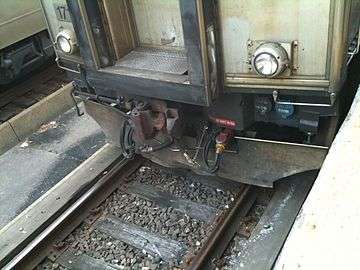Jumper cable
Jumper cables are electric cables to connect two rail or road vehicles.

Rail
Jumper cables are between the locomotive, the railroad cars and the cab car or the driving van trailer on push-pull trains for multiple-unit train control and the transmission of lower voltage electricity (head end power).
Road
Jumper cables are electrical cables between the road tractor and a semi-trailer or a full trailer or the electrical cables between an automobile and any trailer.
Jump starting
A car with a "dead" (discharged) battery can be made to start by supplying it with power from an external source, such as the battery of another car. The cables used to make the necessary temporary connection are also commonly called "jumper cables". These usually are equipped at the ends with alligator clips.[1]
References
- Gilles, Tim (2012). Automotive service : inspection, maintenance, repair ( (5th ed.). Boston, MA: Cengage Learning. ISBN 978-1111128616. OCLC 908542447.